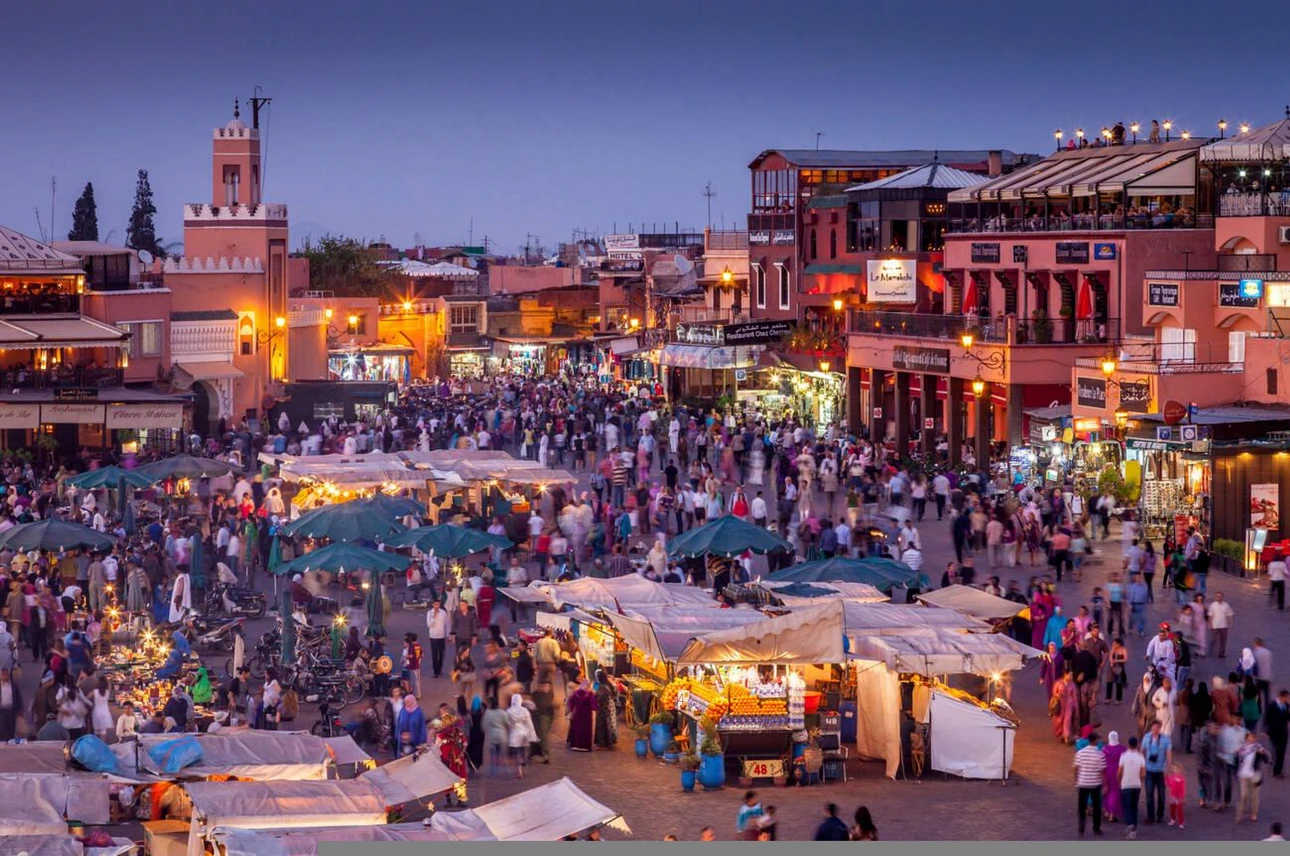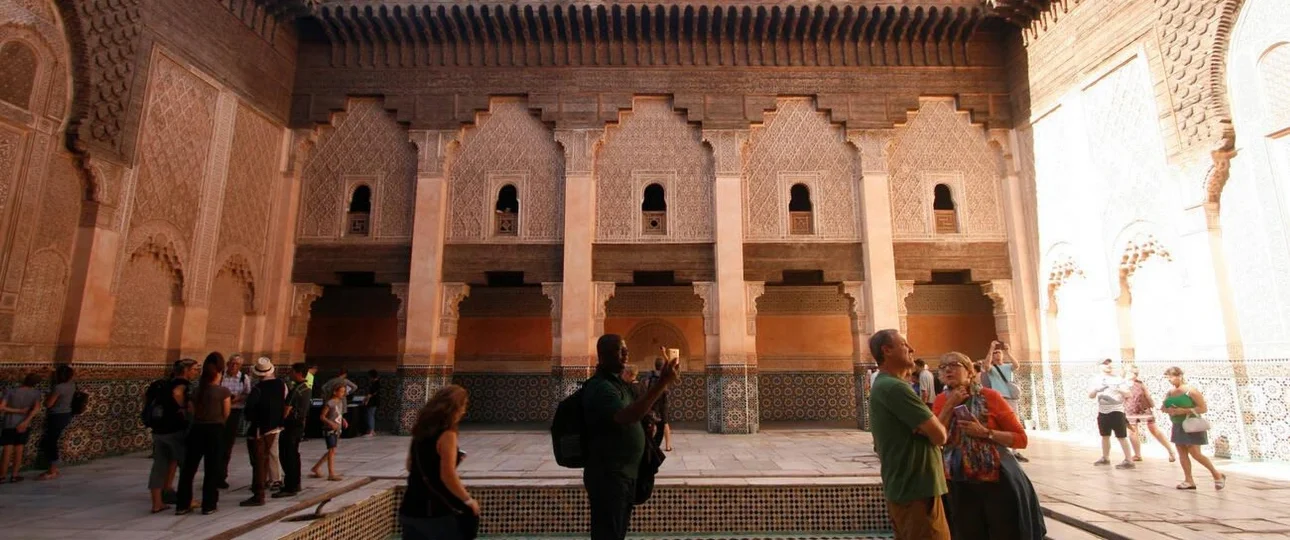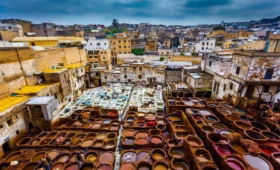Marrakech, often called the “Red City” due to its distinctive terracotta buildings, is one of the most iconic and exciting destinations in Morocco. A city that beautifully blends ancient traditions with modern luxury, Marrakech offers visitors a sensory overload of colors, sounds, and smells. Whether you’re a history buff, a culture enthusiast, an adventurer, or someone simply seeking relaxation, Marrakech has something for everyone. Here’s a guide to this fascinating city:
1. The Medina: A Step Back in Time
At the heart of Marrakech lies its Medina (old town), a UNESCO World Heritage site that’s like stepping into a living museum. Narrow alleyways, vibrant souks (markets), and majestic palaces will transport you to the city’s glorious past. As you wander through the maze of streets, you’ll encounter centuries-old buildings, hidden riads (traditional Moroccan houses), and bustling markets selling everything from spices, textiles, and jewelry to beautiful pottery and leather goods.
Jemaa el-Fnaa: The city’s main square, Jemaa el-Fnaa, is the soul of Marrakech. By day, it’s a colorful marketplace with street vendors, musicians, snake charmers, and storytellers. As the sun sets, the square transforms into an outdoor restaurant, with food stalls serving delicious Moroccan dishes like tagine, couscous, and pastilla.
Must-Visit Souks: Marrakech’s souks are a labyrinth of stalls filled with treasures waiting to be discovered. The Souk Semmarine offers stunning Moroccan textiles and clothing, while Souk el-Attarine is a paradise for fragrance lovers, with its selection of spices, perfumes, and essential oils.

2. Majestic Palaces and Gardens
Marrakech is home to some of Morocco’s most impressive palaces and gardens, reflecting the city’s imperial past.
- Bahia Palace: Built in the late 19th century, Bahia Palace is a masterpiece of Moroccan architecture. With its stunning courtyards, intricate tile work, and lush gardens, it’s an unmissable highlight in Marrakech. The palace was designed to showcase the grandeur and luxury of the ruling elite of the time.
- Jardin Majorelle: One of the most famous gardens in the world, Jardin Majorelle was designed by French artist Jacques Majorelle in the 1920s. Known for its vibrant blue color, the garden is a peaceful retreat from the bustling city. It houses a variety of exotic plants, including cacti and palm trees, and the Berber Museum provides a fascinating insight into Morocco’s indigenous culture.
- Agdal Gardens: For a more tranquil experience, head to the Agdal Gardens, a vast area of orchards and pools built in the 12th century. The gardens were once a royal retreat and are perfect for a relaxing stroll or a picnic.
3. The Saadian Tombs: A Glimpse into Morocco’s Royal History
The Saadian Tombs are one of Marrakech’s hidden gems. Discovered in 1917, these tombs date back to the 16th century and house the remains of the Saadian dynasty, which ruled Morocco during the 16th century. The tombs are located behind the Kasbah Mosque and are renowned for their intricate decoration, including stunning tile work, carved stucco, and ornate marble tombs. It’s a quiet and serene spot, offering a fascinating glimpse into the city’s royal past.
4. Moroccan Cuisine: A Feast for the Senses
No visit to Marrakech is complete without experiencing its gastronomy, which is as rich and varied as its culture. From street food stalls to fine dining restaurants, there’s something for every taste.
- Tagine: The iconic Moroccan dish, tagine, is a slow-cooked stew made with a variety of ingredients such as lamb, chicken, vegetables, and dried fruits. Each dish is uniquely spiced and prepared in a traditional clay pot that gives it its distinct flavor.
- Street Food: Try the msemen (Moroccan flatbread), chebakia (fried pastries), or a bowl of harira (traditional Moroccan soup) from one of the many food stalls in Jemaa el-Fnaa. Don’t forget to wash it down with a glass of mint tea, a sweet and refreshing drink that is Morocco’s national beverage.
- Fine Dining: For a more upscale experience, Marrakech offers a variety of high-end restaurants such as Le Comptoir Darna or La Mamounia, where you can enjoy gourmet Moroccan and international cuisine in an elegant setting.
5. A Hub for Arts and Culture
Marrakech has become a cultural hotspot in recent years, attracting artists and creatives from around the world.
- The Marrakech Museum: Housed in the magnificent Marrakech Palace, the museum showcases contemporary art and traditional Moroccan art, as well as exhibits on the country’s rich history and culture.
- Festival of Popular Arts: Held annually, this festival celebrates Moroccan music, dance, and theatre. With performances in the Jemaa el-Fnaa square, it’s an immersive experience in the heart of the city’s vibrant culture.
- Photography and Art Galleries: The city is home to many galleries such as the Photography Museum of Marrakech, which offers a visual exploration of Moroccan history and life through the lens of local photographers.
6. Where to Stay in Marrakech
Marrakech offers a wide range of accommodation options, from budget-friendly hostels to luxurious riads and five-star hotels.
- Riad Hotels: For an authentic Moroccan experience, stay in a riad—a traditional Moroccan house with an interior garden or courtyard. Many riads have been converted into boutique hotels, offering a peaceful oasis in the heart of the city. Riad Kniza and Riad Yasmine are highly recommended for their excellent service and tranquil atmosphere.
- Luxury Hotels: If you’re looking for a more lavish stay, Marrakech has some of the most luxurious hotels in Morocco, such as the famous La Mamounia and Royal Mansour, both offering world-class amenities, stunning gardens, and exceptional service.
7. Getting Around Marrakech
Getting around Marrakech is relatively easy, thanks to the availability of taxis, horse-drawn carriages, and walking. The Medina is best explored on foot, as its narrow streets are not accessible by car. You can also hire a petit taxi (small taxi) for trips outside the city center or to the new town, Gueliz.
For a unique experience, take a ride in a traditional calèche (horse-drawn carriage) around the city’s famous landmarks.
Conclusion
Marrakech is a city that captures the essence of Morocco: it’s vibrant, historical, and full of life. Whether you’re exploring ancient palaces, getting lost in the maze of souks, or simply sipping mint tea in a quiet courtyard, Marrakech will leave you with unforgettable memories. Its rich culture, warm hospitality, and beautiful landscapes make it one of the top destinations in North Africa.
So, what are you waiting for? Pack your bags, and get ready to immerse yourself in the magic of Marrakech!


